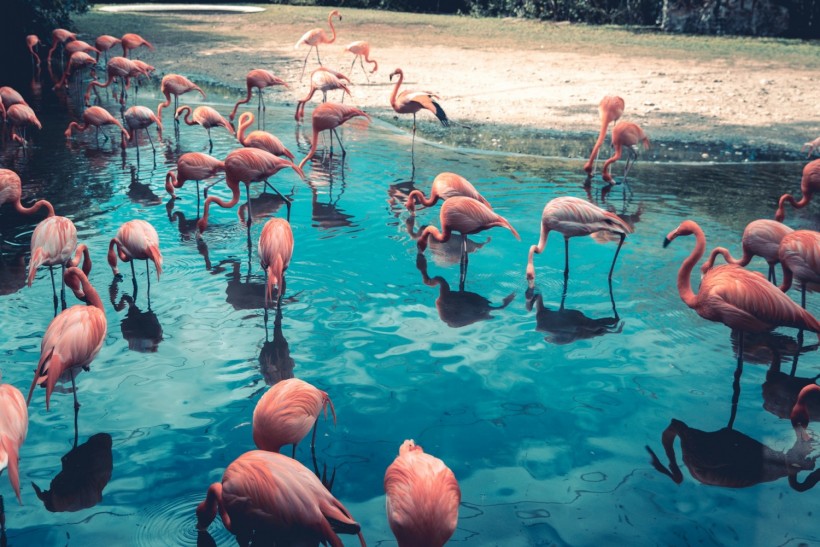Flamingos have to be one of the most visually striking bird species. These social birds flock together, and the sight of hundreds of birds in long, curved flying formations or strolling down the shoreline is a breathtaking scenario. Over a million lesser flamingos congregate on big lakes during the breeding season.
With their necks and legs stretched out straight, these birds create a magnificent and striking sight when they take flight in groups; a big white and pink cross. This creature's exotic appearance and unusual charateristics have helped solidify its place in the animal kingdom.
Eight such strange flamingo factors are here to satisfy the interest of bird lovers and anyone curious to learn more about this stunning species.
1. Flamingos Get Their Pink Color from Their Food
Flamingos get their signature pink color from their food, which also contributes to their unusual appearance. Indeed, flamingos are what they consume. Carotenoids are natural pigments that plants make. They can be found in various colors, including red, yellow, and orange. Carrots and ripe tomatoes get their vibrant colors from a carotenoid called beta-carotene. And they're present in the minuscule algae that brine shrimp devour. A flamingo's pink feathers result from the animal's metabolism of the pigments in the algae and brine shrimp it eats.
2. These Giant Birds Can Fly!
Adult flamingos weigh only between four and eight pounds, although they can grow as tall as four to five feet at maturity.
These animals that live in a lake and mostly cluster on the ground and stroll can also be spotted flying through the air. When the seasons change, some flamingos will move to a new water source, while others will travel south for the winter. Flamingos are migratory birds. Flamingos are known to fly vast distances at night if they must.
3. The Flamingo Turns Its Head "Upside Down" to Eat
Flamingos are specialized for filter feeding, which requires them to consume with their heads in an inverted position. You might think of oyster beds or baleen whales when you hear the term "filter feeder," but flamingos also fall into this category. They eat anything that lives on the water's surface, which includes algae, small seeds, tiny crustaceans like brine shrimp, fly larvae, and other aquatic organisms.
Feeding time for a flamingo means submerging its entire body in the water and eating with its head upside down. The bird then moves its head from side to side while its tongue pumps water into and out of its bill. The plates that resemble combs along the bill's edge act as a filter, allowing water to drain away while keeping food inside.
4. Flamingos Stand on One Foot
The flamingo can stand on one foot for extended periods, even long enough to fall asleep. Some researchers have also hypothesized that Flamingos' tendency to stand on one leg may aid the species in maintaining a constant body temperature. Birds' limbs are major heat sinks, allowing them to cool off rapidly. Flamingos may slow the rate at which heat is lost through their feet by standing on one leg.
Flamingos bring one foot up and tuck it beneath the other. In the cool water that is close to their feeding grounds. Much to the shock of everyone, it has been found that this behavior does not result in leg weariness or discomfort. Rather, According to studies, flamingos use more muscle force when resting on two legs, so it is possible that keeping their weight on one leg is easier on their legs.
5. Flamingos Feed Their Offspring The Foods They Produce
Flamingos are unique because they provide their young with the food they create themselves. The "milk" of a flamingo is created in the harvest, a section of the bird's throat; following production, the "milk" is brought up through the mouth. The harvest milk of a flamingo is often called crop milk which is loaded with the proteins and fats that their young require, even though the thought of it can be revolting.
Both parents of a Flamingo chick can produce crop milk, which will sustain the chicks until they become old enough to hunt and gather food.
6. Sometimes Flamingo Egg Yolks Are Pink
There are occasions when the yolks of flamingo eggs have a pinkish hue or rosy color. In contrast to what most people believe, the exterior of a flamingo egg is white, while the interior might be yellowish or reddish in color. Flamingo eggs are similar to the appearance of chicken eggs. However, every once in a while, the yolk of a flamingo egg will have a pinkish or even reddish tint.
7. Flamingo Nests Are Made of Mud
The nests of flamingos are constructed out of mud. One big egg can be laid in a flamingo's mud volcano-like nest. Flamingos are monogamous, and both parents contribute equally to their offspring's development. They both contribute to building the nest and caring for the egg once it has been laid.
Flamingo chicks are born with perfectly straight beaks and feathers that are a downy white-grey color. It takes some time for these birds to reach their adult pink color and develop their distinctive hook-shaped beaks before they are fully mature.
8. Flamingo's Knees Don't Actually Bend Backwards
Flamingos cannot bend their knees backward. Flamingo legs can twist in the same way as human legs. In the lower leg joint, where both human and flamingo knees contain their thigh bones and kneecaps, there are similarities between the two species' knees. They can conceal their knees thanks to the position of their body and feather, which are higher up on the leg. Imagine a Flamingo is making a conscious decision to avoid being seen. The lower leg is the part of a person's leg that rotates as they twist.
Final Words
Flamingos are famous for their unique features. If this is the first time you have heard of these birds, you must pull up images from the internet to familiarize yourself with these tropical-wading birds with a pink hue, curved necks, and long legs.
© 2024 NatureWorldNews.com All rights reserved. Do not reproduce without permission.
* This is a contributed article and this content does not necessarily represent the views of natureworldnews.com






